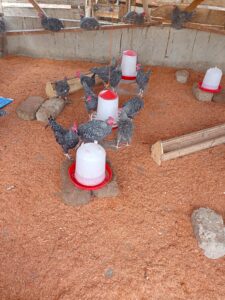Quality Protein Maize: Implementing lessons learned from World Food Prize Laureates
Quality Protein Maize

SHI Promoting Good Nutrition Meeting
By Bernice Agyekwena, SHI Ghana Communications Manager
Maize remains an important staple in the diet of Ghanaians and is used in many dishes for both infants and adults across the entire country. The only drawback to the extensive consumption by the entire populace is that tropical maize varieties tend to have very little protein and vitamins. Hence, consuming these varieties of maize in high quantities without other dietary supplements high in protein, vitamins, and minerals will long term lead to micro nutrient and protein deficiency.
The development of Quality Protein Maize (QPM) by Dr. Surinder Vasal and Dr. Evengelina Villegas has come to play an enormous role in global food security given the widespread consumption of maize in many parts of the world. For their feat, Dr. Vasal and Dr. Villegas were jointly awarded the Millennium World Food Prize in the year 2000 for improving the productivity and nutritional content of maize.
Quality Protein Maize produces between 70 to 100 percent more lysine and tryptophan than tropical maize varieties. “These two amino acids allow the body to manufacture complete proteins therefore eliminating wet-malnutrition.” (Mamatha et al.)
According to researchers investigating QPM’s contributions to human nutrition, “Quality Protein Maize can be used for diversified purposes in food and nutritional security as infant food, health food/mixes, convenience foods, specialty foods, and emergency ration, in fulfilling the protein requirements of different sections of society (infants, lactating mothers, convalescing patients, kwashiorkor diseased, old persons and infirm, etc.).” (Mamatha et al.)
World Food Prize past president Ambassador Kenneth M. Quinn noted that “When QPM was fed to babies after weaning, they were healthier and at much lower risk for malnutrition disorders such as marasmus and kwashiorkor that often resulted in death. QPM offered 90 percent of the nutritional value of skim milk, the standard for adequate nutrition value. The inclusion of QPM in daily rations greatly improved health, reduced incidence of disease and saved lives.”
Hence, it is the high nutritional content of Quality Protein Maize as well as its suitability for the preparation of all traditional Ghanaian maize based recipes that Self-Help saw it fit to promote it as a dietary solution to the high incidence of malnutrition amongst children in some of its beneficiary communities.
Under Self-Help International’s Growing Healthy Food, Growing Healthy Children (GHFGHC) Program, and its School Feeding Program, Self Help has directly intervened in the nutritional status of many children and their mothers in these communities. The timely intervention of the GHFGHC Program in the life of Akosua, a 20-year old resident of Beposo helped reverse malnutrition in her 19-month old daughter, Lapope.

SHI School Feeding Program
Explaining her predicament to the GHFGHC team, Akosua said she became pregnant with her second child when Lapope was just 12 months old and was compelled to stop breastfeeding her. Even though she realized her daughter was losing weight, she did not know what to do because access to food has always been a challenge for her family.
“Diversified meal was not in our dictionary- the only food in our diet was akple, a dish made from corn (maize) flour and grinded pepper and sometimes ayoyo, a green leafy vegetable soup. Any left over akple will be mashed with sugar for breakfast and sometimes lunch.”
Akosua said her family depended on this single dish for survival for many years until a friend told her about Self Help and the nutrition programs that they are running to improve upon the health of babies and mothers in her community. She immediately decided to participate in the program.
“Although I registered with the program as an expectant mother, I attended meetings with my 19-month old daughter. The moment the nutrition officer saw my girl, he realized she was malnourished and registered her with the program as well. My girl and I were supplied with a food supplement called Tom Brown which is a mixture of Quality Protein Maize, groundnuts, and water. Upon further nutritional analysis of my baby and I, we were given eggs to help improve upon our macro- and micro-nutrient status.”
Self-Help also supplied Lapope with Ready to Use Therapeutic Foods (RUTF) to enable her to catch up with her growth following a medical examination that confirmed she had no underlying health condition. “With these food supplements, my girl is now growing well and I can confidently say my unborn child will be born healthy.”
Akosua said the GHFGHC Program had saved her and her family. For this reason, she opted to cultivate Quality Protein Maize and she is one of 70 women in Beposo currently cultivating the crop which is a vital component of Tom Brown, a nourishing meal for both adults and children.
After undergoing training to learn the skills involved in the cultivation of Quality Protein Maize, these 70 women were provided with seed, fertilizer, and herbicides with the onset of rains in 2017 to cultivate their own fields, thus ensuring that the cultivation and consumption of Quality Protein Maize has come to stay in Beposo to help fight malnutrition in the community.
Quality Protein Maize also forms the bedrock of the School Feeding Program being implemented by Self Help in some beneficiary communities. School children in schools under the School Feeding Program are provided a daily breakfast of porridge made from Quality Protein Maize. The program has not only improved upon the nutritional status of children but has led to an increment in school enrollment and attendance since the children are sure of a good quality breakfast anytime they attend school.
Currently, 800 school children from 10 schools are being provided with Quality Protein Maize porridge, which is a big step towards addressing child malnutrition in Ghana.




